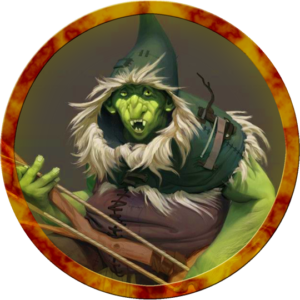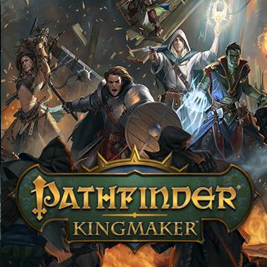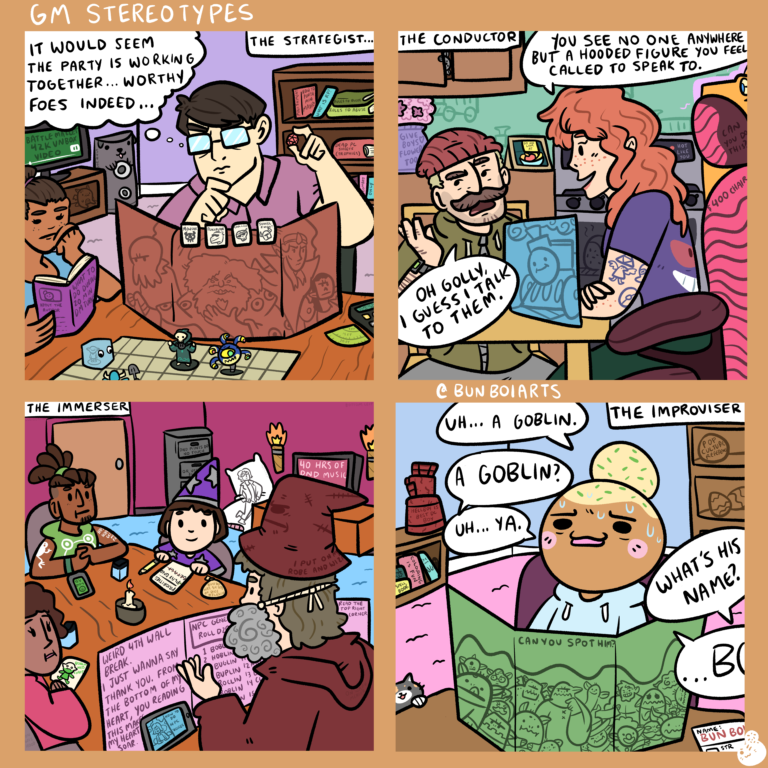Pathfinder 2E – The Goblin Lore Bard
 Bard is one of the core classes in both Pathfinder 1st and 2nd edition. However, the much simpler 2E ruleset provides a different playing experience than what a typical player will expect from 1E. Some of the changes work well while others take some time getting used to, especially if you are a long-time 3rd Edition D&D player like me.
Bard is one of the core classes in both Pathfinder 1st and 2nd edition. However, the much simpler 2E ruleset provides a different playing experience than what a typical player will expect from 1E. Some of the changes work well while others take some time getting used to, especially if you are a long-time 3rd Edition D&D player like me.
This month concludes the adventures of my first Lore Bard. As there are many writeups on Bard builds, and the official site details the class well, I will be focusing on how it felt to play the new 2E Bard rather than simply build one.
For those who don’t want to read the entire writeup, the Bard class in general is greatly improved in 2E. The new rule system is set up in such a way that it is no longer a secondary class and can operate as a key party member. That said, I would shy away from the Lore Bard, which is the focus of this post. Instead, go with the Maestro Bard. Moreover, as interesting as Goblin was during my runs, I would also do a Human Bard if this is your first time playing.
Introducing the Goblin Bard
Goblins are the most interesting addition to the core races (called “Ancestries” now) in Pathfinder 2E. This ancestry works best as an Alchemist or a Rogue but reading the Goblin feats will reveal that the Bard is considered Tier 2 option. The Goblin Song feat as well as the Charisma boost means you will see a lot of them in your campaigns.
If you are new to Pathfinder, I do support the general online recommendation for picking Human ancestry. In play, Goblin Song was very useful for mob control, but it was more or less the only choice I had. Humans on the other hand get more diversity and are easier to play in the new mechanics. If you are picking Human for roleplaying purposes, know that the ancestry you choose has more to do with your play style than the stats unless you are using pre-made campaigns. The official Paizo materials have a lot of well-placed Goblin mentions in the runs I’ve done so far, but very few of them seem tailored specifically for a Goblin player.
Introducing the 2E Bard
In first edition, and D&D 3E system in general, Bards were kind of the “do it all” support character. They carried an insane level of knowledge checks, could case arcane spells, and buffed regularly. However, they were able to do these things but rarely excelled at any one area other than knowledge checks. This was its downfall though. For example, the mediocre arcane casting was always secondary to your primary caster who, after level 10, outmatched anything you had available.
As the party buff generator, a good support character usually has AoE or healing capabilities which put you in second place again. Moreover, the buffs in 1E were low in importance as magical items and stat increases were more valuable than any temporary buff that you had to renew every turn. In 2E, this changes. Buffs are incredibly powerful but more on that later.
A couple of other notes. In 2E, you are no longer an Arcane caster but an Occult caster. This gives you access to an entire list of spells that your wizard can’t access. The downside to this is that many Occult spells are full round actions or require sustaining, so using buffs or other actions become challenging when casting. Finding a way to buff without costing an action point greatly improves the potential of the Bard’s casting capabilities in the group. This is the main thing you need to consider when deciding how to build your Bard character.
The Lore Bard Build
I selected an Enigma Bard for my 2E run, also known as the Lore Bard. When you create a Bard, you select a muse which defines the type of Bard you play. On paper, the Enigma seemed to be the closest to the “do it all” type of class I usually play. I know the description of the Polymath Bard says it is the “jack of all trades” the reality is it is the Diplomacy Bard. Lots of other classes can get Charisma-based boosts which makes Polymath “meh” on its own. Only the Enigma Bard gets Bardic Lore, essentially the catch-all for knowledge checks that allows you to always role a check, but also never get the best possible roles, just like in 1E.
If you go this route, make sure you work with your DM in advance. This class is terrible if you are not in a lore rich or heavy roleplaying environment. A lot of the pre-built campaigns have specific lore built into them and your ability to capture important details are based on how the material is written. If you aren’t making constant knowledge checks you aren’t using Enigma properly as your direct combat capabilities will probably stink.
Moreover, there is a specific feat called Dubious Knowledge which I highly recommend for the Lore Bard. I had so much fun with this, as it provides you with a bit of false and true information and you must piece together which is the right one. But again, this is only as good as your DM’s preparation for the campaign, so make sure you are working with him in advance.
The drawback to Lore Bards is how useless compositions became. I rarely found an opportunity to use Loremaster’s Etude. Counter Performance is so circumstantial its entirely possible you won’t use it at all, even in some of the pre-built campaigns or wherever spellcasting is lacking. I ended up using the Etude at the end of a combat just to say I did something. One time, using Etude to identify a creature actually initiated an unwanted combat so there is that as well.
As a Lore Bard, I found it hard to use full round spells. I would shy away from those unless you are a Buff Bard, as you are just wasting spell slots if you take them. Leave full round spell casting to dedicated spell casters. In addition, never underestimate the Bard’s ability to influence Will saves. I found Intimidation, Goblin Song, and Fascinating Performance made a difference in several key combat sequences. Especially for mob control, these were highly beneficial, and even more so when done in tandem will spellcasters that target Will saves.
How It Plays
I ran the Lore Bard on a few play tests, and I have to say, it is pretty “meh.” For the first few levels it was fun and those party buffs are incredible. Using a combination of Inspire Courage and Telekinetic Projectile, I was dealing over half of all the party’s damage for the first few levels (keep in mind you deal damage through the attacks of others. Make sure you count that as your own damage). However, by level three, as magical items start entering the game, your ability to cast spells and buff others was far more important than making a bunch of knowledge checks. I was also increasing the hit and critical range of my party by 20% or more while using Inspire Courage. This is where having only Loremaster’s Etude and Counter Performance as your only focus spells begins to lag behind, unless you were very careful with your spell selections and picked ones that work in tandem with your divine or arcane caster.
This drawbacks of a Lore Bard is actually mitigated entirely by another Bard type. I especially like the Maestro Bard, also known as the Buff Bard. This is hands down the best version of the Bard and is so good I recommend it as a core class for your group. The Lingering Composition feat is so versatile. It allows you to make full round actions, opening some very power spell options in the Occult category. Moreover, Soothe turned out to be my most used spell which is a free spell for the Maestro muse. To give you an idea of how important it is, I ended up writing a song about how many times I used this spell to save our party’s dedicated healer. I originally discounted the importance of Sooth when I picked my muse, thinking I would be insulting our healer, but in 2E rules hitting 0HP is more common and this was a critical addition. In fact, I had to use this spell to bring back our full Cleric in half of all encounters in the first campaign. It’s so critical that you get Maestro that I recommend you pick up the Multifarious Feat at level 2 if you didn’t pick it at the start.
The 2E rules don’t allow you min/max as easily as the old system. Leveling paths are a lot simpler and it is harder to make class breaking mistakes during leveling. With that in mind, the most important change to the rules in 2E is the way that buffs work which, I have to say, made a big difference in every single session I played. At first glance you don’t see the changes as easily, but I recommend keeping a tally of every time your buff made a difference in a hit/miss, or a saving throw succeeding/failing. You’ll find that a Buff Bard makes s big difference in the success/failure ratings of your entire party. Take particular note in climatic fights where you can influence 50% of the total damage dealt during the encounter. One of the most important things your buffs do is beating thresholds for critical fails/success, which means a lot in this new system.
In 1E, for example, skill, hit, and AC bonuses could be so high, often in the 30’s by mid game, having loads of magical items made the most difference in combat. These bonus ranges are not as wide in 2E. One specific example is in 2E, for each +1 buff you have, it means 5% increased critical hit chance. That stacks by the way. In other words, that means if you can provide a +4 bonus, you are critical hitting 1 out of every 5 hit with the bonuses alone!
In actual play, this usually meant the difference between life and death once we were on initiative. I am not exaggerating. When myLevel 2 Bard was buffing, we collectively dealt 15% more damage as a party of 4 when compared to our damage output when he wasn’t buffing. This was consistent across multiple sessions, regardless of if he was a Maestro or Enigma Bard. I do not remember ever seeing numbers that good in the 1E system.
Conclusion
The Bard is greatly improved in 2E. It feels like a proper Tier 1 class now. However, I do not recommend the Lore Bard unless your DM has specifically mentioned it will be a lore or roleplay heavy campaign. If you do go Lore Bard, make sure you read through the lore specific feats, otherwise you are going to be a Buff Bard with marginal buffing capabilities by level 10.
For every other case other than roleplay, I highly recommend the Maestro Buff Bard. Your ability to cast buffs, deal damage and healing across your party, and the ability to cast full round spells will make you extremely powerful. The Maestro is the first Bard I’ve played that feels like a truly unique class and not just a mash up of other classes rolled into one. It’s a nice change and, playing it as a Goblin, can provide an extremely potent combination.




Great post, I love this style.